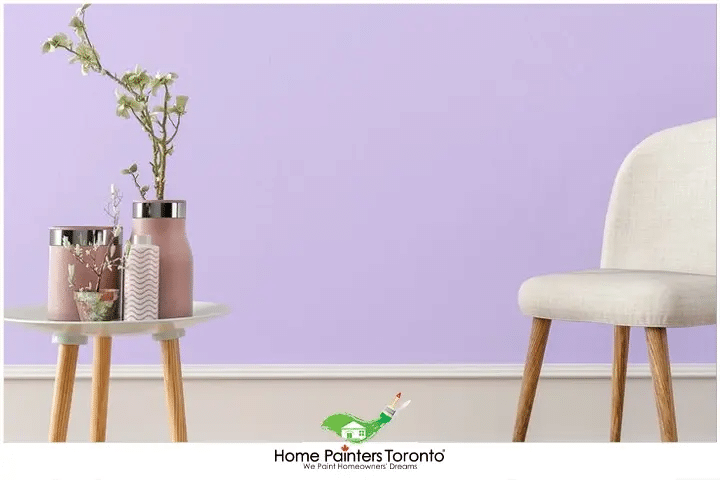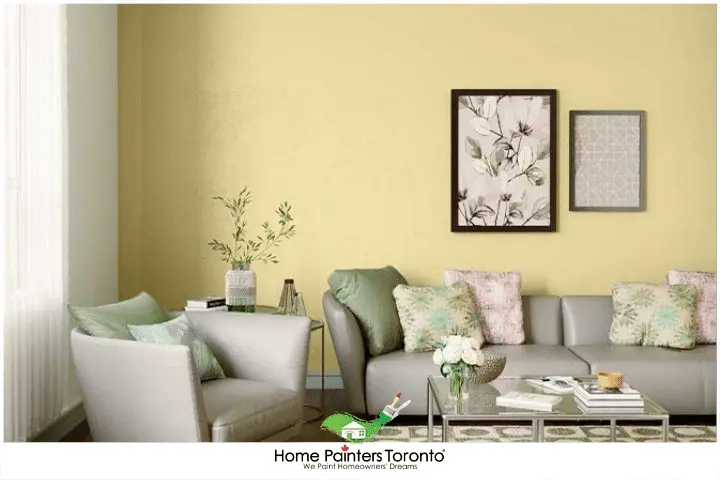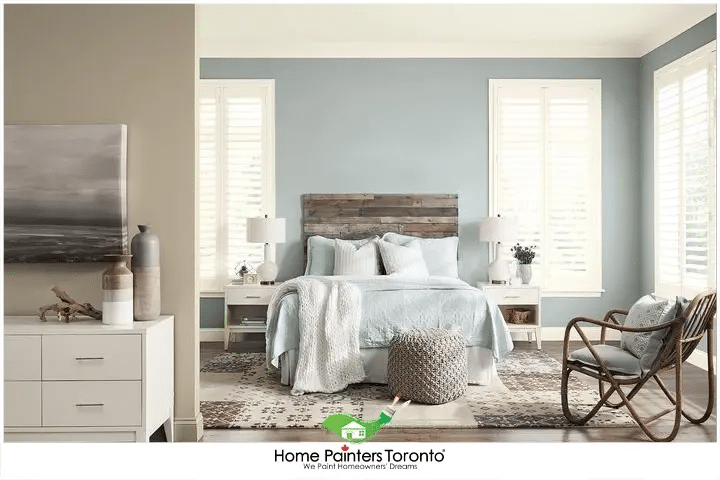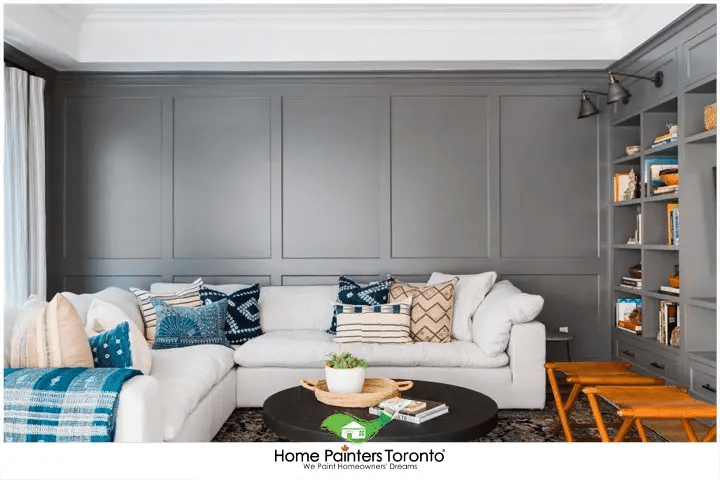
You would think painting a room consists of knowing what colour you want, but that’s not the main thing sometimes. Figuring out how a certain colour appears in different lighting is something a lot of people don’t focus on. As you can imagine, your room will not always be bright; it will be dark. Picking a paint colour that reflects the best both in bright and dark settings is vital. Paint colours that are too cool and don’t work well in dim environments can make your home uninviting. Instead, if you turn on your lamps and play around with them, you will notice that warmer shades work well in dark spaces.
Creating a welcoming place for yourself and visitors is always possible. So, what are the best paint colours for low-light rooms? There are many eye-popping shades that can rescue your home from being too dark.
Best Paint for Low-light Rooms
Lavender Paint In Low Light Rooms
Lavender is very flexible and works extremely well in low-light settings. In addition, it is also a playful colour when mixed with bold blues and purples. It is sophisticated for all rooms and in any lighting.

Chocolate Brown
Have you always wanted a cozy atmosphere that is not too dark? Look no further than a chocolate brown shade. It is inviting and warm, while also being a very strong colour. How do you balance a strong colour from being too overbearing? You match it with light accents, such as designer fabrics or neutral carpets.
Pale Yellow
Sunny yellow walls combat low-light rooms because what’s better than natural lighting? Pale yellow looks great as the dominant colour while having a white backdrop or white furniture. It even looks great with warm wood tones.

Warm Orange
Various shades of orange illustrate warmth and feelings of togetherness. This includes pumpkin, tangerine, and apricot. Not to mention that when the room is bright, shades of orange light up and glow radiantly. Orange gives out Thanksgiving vibes as well.
Powder Blue
Even in a low-light room, shades of blue can lighten up your space! When coupled with clean white details or even dark tones, powder blue is well-suited as the focal point. In addition, even when paired with bright colours like red and green, shades of blue would still pop out.

Grays
Grays are usually the “dull” colour, but are now considered trendy. This is because it is a great neutral colour that can actually make your setting stand out from the pack. A light tone like a stone hedge or a darker tone like mountain gray can provide a base for shining colours. Not to mention that shades of gray blend perfectly with black and white. In interior design, elegant grays are a staple. The main element of this is that it works perfectly with non-sun and sunny areas. If your setting is lighting dimmed, you should consider choosing a lighter shade of gray for the walls to compliment any bright accents you may have.

Cheerful Pink
When sunlight does not appear, pink is a great choice for low-light rooms. It is bright enough to withstand such darkness and shades like watermelon and fuchsia. Although mostly used in girl’s bedrooms, cheerful pink is great when you need some light in your home.
Lime Green Paint For Low Light Rooms
This colour is a real energizer! Whether your space is small or large, lime green will make it stand out from the pack. Most people use it for accent walls but feel free to do whatever you feel makes your room comfortable. Let’s say you’re not in the best mood and you want something to cheer you up.
It may be a small thing, but being in a room with lime-green walls could do just that: make you feel better. In addition, lime green is used in bathrooms or even a laundry room.
If Confused, Use A Colour Wheel!
When picking the right colour, don’t forget about the colour wheel. Remember in primary school when we learned about the colour wheel: red, yellow, and blue? Combining these colours will give you secondary choices (orange, purple, etc). That information comes in handy when picking the right colour for your room. In addition, going through the colour wheel will allow you to decide which tone you want your room to have: cool, complimentary, warm, shaded, or vibrant. Giving your room a certain vibe is what homeowners look for. Had a bad day? You would want to use cool or warm shades to make you feel more relaxed. Are you a moody type of person? Maybe you would use darker tones to resemble that aspect of your personality. Whichever direction you go, there is no wrong answer!
What Type Of Paint To Use for Low Light Rooms
When starting a new home project that requires painting, most people assume that picking the colour is important. While it is, it isn’t actually the top choice. The biggest and most vital task is choosing what type of paint to use. There are a variety of paints to choose from water-based, oil-based, acrylic, latex, and many more. Oil-based paints are used on wood, paintings, and metals. Why use oil-based paint? The finishing touch comes out glossy and smooth. It does take days or even weeks to dry, but it does not easily stain. In addition, while oil-based paints are harder to use, they are thicker than other paints.
Paint Colours For Low Light Rooms
Realistically, any paint colour that you feel best represents your inspiration and home is a good choice. When choosing a paint colour for low light rooms, it is important to remember how it will light up in dark spaces and how that particular colour makes you feel. Also, when choosing a paint colour for low-light rooms, remember that warmer shades work well in dark spaces. So, what are the best paint colours for low-light rooms? There are many eye-popping shades mentioned and plenty more! The decision is always yours to make.
Paint Finishes and Lighting: A Shining Partnership
Lighting and paint are individually powerful elements of interior design, and when used in harmony, they illuminate a relationship that’s nothing short of spectacular. As we delve into the realm of paint finishes and their interactions with light, rest assured, that you’ve got a guiding hand that makes the journey less intimidating, more manageable, and inevitably more satisfying.
An Introduction to Paint Finishes
The battle against gloominess often resides in the details. Your chosen paint finish has a significant influence on how much light will reflect off the walls and how it’s distributed within a room. Here’s a quick breakdown:
- Matte (or flat) finish: This finish has no shine, making colours appear more pure. However, it absorbs light, which may contribute to a room looking dimmer.
- Eggshell and satin finishes: The light sheen of these finishes can reflect light without being overly glossy. These can be good intermediate options that offer a combination of modest lustre and moderate light reflection.
- Semi-gloss and gloss finishes: The highest shine among finishes, these reflect the most light. Beware, though, as they can also highlight any imperfections on the wall surfaces.
A Symbiotic Relationship: Paint Finishes and Room Lighting
Now that we’ve navigated the basics, let’s match up these finishes with lighting conditions:
Low Light: The Semi-Gloss Solution
In low-light conditions, a semi-gloss finish can be your knight in shining armour. Its light-reflecting paint for dark rooms gives the room more brightness. However, only embark on this choice if you’re sure of smooth wall surfaces.
Moderate Light: The Balanced Approach of Eggshell or Satin
Rooms receiving moderate amounts of natural or artificial light pair well with eggshell or satin finishes. They bestow upon your walls a delicate and attractive sheen, aiding in scattering the present light evenly.
Abundant Light: The Bold Choice of Matte
Matte finish, with its lack of shine, can have a luxurious, velvety look in a well-lit room. The richness of colour rendered by a matte finish is second to none and can perfectly enhance rooms that are luxuriously lit, natural or artificial.
Remember, selecting the right finish and paint colours to make a room look brighter isn’t just about aesthetics. It’s about a nuanced balance between light, space, and mood. With this understanding of how paint finishes and light operate in sync, you’re well-equipped to construct a dynamic and well-lit space.
Take your time and understand your space, lighting conditions, and personal preferences. This isn’t just about colouring walls; it’s about infusing life and bringing your room’s character to shine. May you paint a world of your own, beautifully lit and resoundingly vibrant!
Most Interesting Blogs Related to
“Best Paint Colours For Low Light Rooms”
Need someone else to handle all the interior painting work for you? It sounds like you need some interior painting services that will get the job done fast and right! Give us a call at 416.494.9095 or email Brian@HomePaintersToronto.com for a FREE quote. And don’t forget to follow us on all our social channels below!





